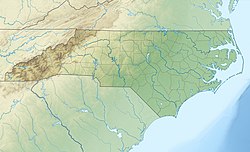| Pekin Formation | |
|---|---|
| Stratigraphic range: Late Carnian, ~ | |
 Weathered claystones from the Pekin Formation | |
| Type | Geological formation |
| Unit of | Chatham Group |
| Underlies | Cumnock Formation |
| Thickness | 542–1,240 metres (1,778–4,068 ft) |
| Lithology | |
| Primary | Sandstone |
| Other | Siltstone, shale, conglomerate |
| Location | |
| Region | North Carolina |
| Country | |
| Extent | Sanford Sub-basin, Deep River Basin |
| Type section | |
| Named for | The village of Pekin, Montgomery County |
| Named by | Campbell & Kimball |
| Year defined | 1923 |
The Pekin Formation is a Late Triassic (Carnian) geological formation in North Carolina. The Pekin Formation is specific to the Sanford Sub-Basin of the Deep River Basin of North Carolina, although it may be equivalent to the Stockton Formation of Pennsylvania, New Jersey, and New York. The Pekin Formation was deposited in a rift basin along the Atlantic margin of North America during the breakup of the supercontinent Pangaea during the Late Triassic. The most common rocks in the Pekin Formation are red to brown sandstones, representing a terrestrial fluvial (riverine) and floodplain environment in a hot, humid climate. It has yielded both abundant plant and animal fossils, including some of the oldest potential dinosaur footprints in the world and the large predatory crocodylomorph Carnufex carolinensis.
